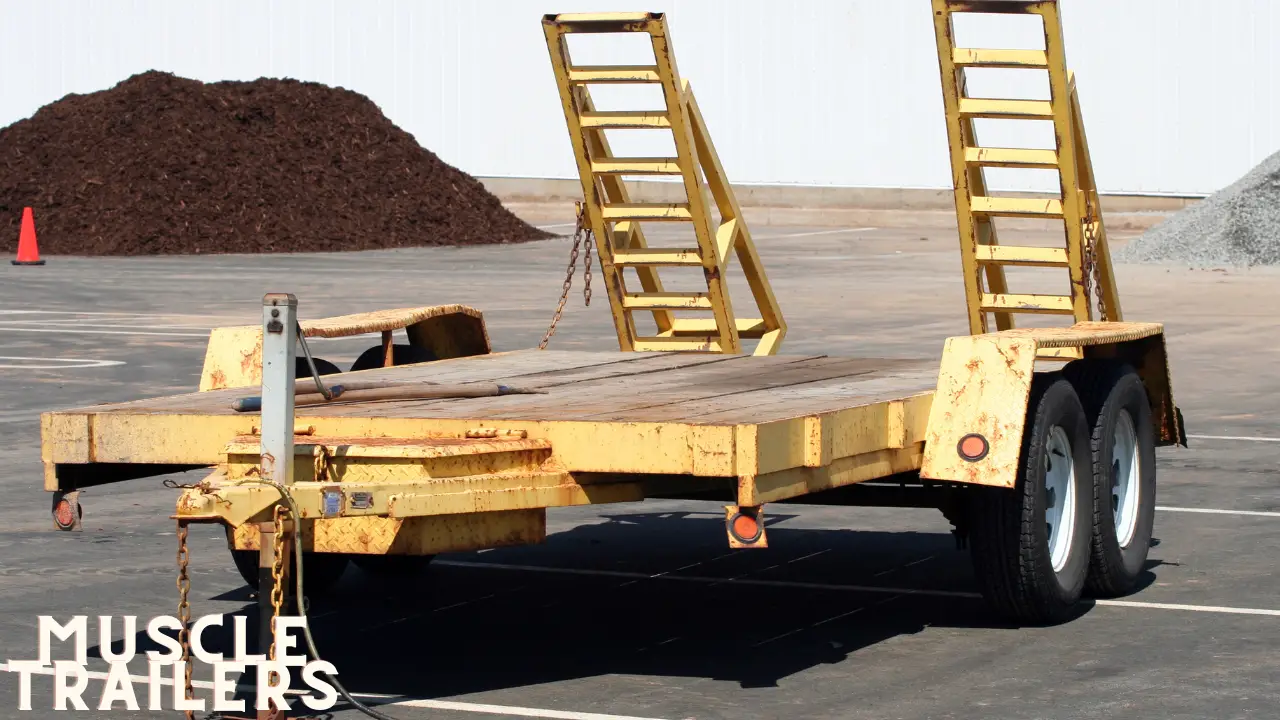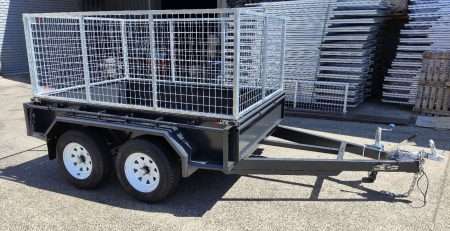
Revolutionize Your Towing: Choosing the Perfect Tandem Trailer Suspension
Understanding Tandem Trailer Suspension
Tandem trailer suspension is a system commonly used in larger trailers, such as flatbed trailers, livestock trailers, and RV trailers, due to their increased load capacity and improved handling. It refers to a system where a trailer is equipped with two axles, each with its own set of wheels. This design provides greater stability and weight distribution compared to a single-axle system (source). Tandem trailer suspension offers improved stability and control while towing, reducing the risk of swaying and improving overall safety (Damel Trailers).
What is Tandem Trailer Suspension?
Tandem trailer suspension consists of two axles that are spaced apart and connected by a suspension system. This configuration allows for better weight distribution and reduces the risk of overloading a single axle. By spreading the load across two axles, tandem trailer suspensions can support heavier loads and provide better stability compared to single-axle suspensions (Timbren). The two axles work together to distribute the weight evenly, minimising the impact on each individual axle and tyre.
Benefits of Tandem Trailer Suspension
The use of tandem trailer suspension brings several benefits to towing and trailer stability. Here are some key advantages:
Improved Stability: Tandem trailer suspension offers enhanced stability compared to single axle suspensions. The presence of two axles and a suspension system helps to minimise swaying and provides better control while towing. This is particularly important when transporting heavy loads or travelling at high speeds.
Weight Distribution: With two axles, tandem trailer suspension allows for better weight distribution. The load is spread across two sets of wheels, reducing the strain on each individual axle and tire. This helps to prevent overloading and uneven tyre wear, contributing to a smoother and safer towing experience.
Increased Load Capacity: Tandem trailer suspension is designed to support heavier loads. The presence of two axles allows for a higher weight capacity compared to single-axle systems. This makes tandem trailers suitable for hauling larger and heavier cargo.
Enhanced Handling: The dual axle setup of tandem trailer suspension improves handling and maneuverability. The additional set of wheels increases traction and stability, making it easier to navigate different terrains and corners.
By understanding the concept and benefits of tandem trailer suspension, you can make informed decisions when it comes to choosing the right suspension system for your trailer. The type of suspension selected should align with the specific needs of your towing requirements to ensure optimal performance and safety on the road.
Factors Affecting Tandem Trailer Stability
To ensure optimal stability and performance of your tandem trailer, it’s important to consider several factors that can impact its overall stability. These factors include weight distribution and load placement, trailer axle alignment, and proper wheel and tyre maintenance.
Weight Distribution and Load Placement
Proper weight distribution and load placement play a crucial role in maintaining the stability of a tandem trailer. Loading the trailer with at least 10% of the trailer weight on the hitch and centring the load as much as possible improves stability (Synthx). Uneven weight distribution or placing a significant portion of the load towards the rear can lead to instability, particularly during turns or sudden manoeuvres.
It’s important to distribute the load evenly between the axles of the tandem trailer. Placing too much weight on one axle can cause that axle to bear an excessive load, potentially leading to premature wear and compromised stability. Consider using tandem trailer fenders to protect your trailer from debris and maintain a balanced load.
Trailer axle alignment
Proper trailer axle alignment is essential for maintaining stability while towing a tandem trailer. The alignment should be checked periodically to ensure that the axles are aligned with respect to the pull direction. Misaligned axles can cause the trailer to pull to one side or lead to excessive tyre wear. Axles should also be aligned perpendicular to the direction of pull and parallel to each other in the case of multiple axles. Consulting with a professional or referring to the manufacturer’s guidelines can help ensure proper alignment and optimal stability.
Proper wheel and tyre maintenance
Maintaining the wheels and tyres of your tandem trailer is crucial for stability and safety. Regularly inspecting the wheels for any signs of damage, including cracks or bent rims, is important. Additionally, ensuring that the tyres are in good condition and properly inflated is essential for optimal stability. Refer to the manufacturer’s recommendations for the appropriate tyre pressure specific to your tandem trailer.
Consider using tandem trailer wheels designed specifically for tandem trailers to ensure proper fit and performance. These wheels are engineered to handle the increased weight and load capacity of tandem trailers, providing added stability and durability.
By paying attention to weight distribution and load placement, trailer axle alignment, and proper wheel and tyre maintenance, you can significantly enhance the stability and safety of your tandem trailer. These factors work together to ensure smooth and secure towing, allowing you to transport your cargo with confidence.
Regulations and Guidelines for Tandem Trailer Suspension
When it comes to tandem trailer suspension, there are specific regulations and guidelines in place to ensure safety and proper operation. These regulations cover various aspects, including maximum load capacity, axle spacing requirements, and load distribution tolerance.
Maximum load capacity
The maximum allowable load on a tandem trailer suspension can vary depending on the jurisdiction and specific regulations. In Quebec, for example, the maximum load capacity for a tandem trailer suspension is 20,000 kg (44,092 lbs) (source). It’s important to adhere to these load capacity limits to avoid overloading the suspension system and compromising the stability and safety of the trailer.
Axle Spacing Requirements
The distance between the axles of a tandem trailer suspension is also regulated to ensure proper weight distribution and stability. In Quebec, the axle spacing requirements dictate that the distance between the axles must not be less than 1.2 metres (3.9 feet) and not more than 2.5 metres (8.2 feet) (Source). Adhering to these spacing requirements helps maintain balance and control during towing.
Load Distribution Tolerance
Proper load distribution is crucial for tandem trailer suspension. Regulations often specify a tolerance for load distribution, ensuring that the weight is evenly distributed across the axles of the suspension system. In Quebec, for example, the load on each axle of a tandem trailer suspension must be distributed as evenly as possible, with a tolerance of 5% difference between the heaviest and lightest axles (source). This requirement helps prevent excessive strain on individual axles and promotes balanced towing.
It’s important to note that tandem trailer suspensions are subject to additional regulations and guidelines regarding tyre pressure, tyre size, and braking systems. These specifications ensure the overall safety and performance of the trailer. To ensure compliance with these regulations, it’s recommended to consult the specific regulations in your jurisdiction or seek guidance from reputable tandem trailer manufacturers and experts.
Understanding and adhering to the regulations and guidelines for tandem trailer suspension is essential for safe and efficient towing. By following these guidelines, you can ensure that your tandem trailer suspension operates within its intended capacity, providing you with a smooth and secure towing experience.
Types of Tandem Trailer Suspension Systems
When it comes to tandem trailer suspension, there are several different systems available, each designed to provide optimal load distribution and stability for the trailer. Let’s explore three common types of tandem trailer suspension systems: leaf spring suspension, torsion axle suspension, and independent suspension.
Leaf Spring Suspension
Leaf spring suspension is one of the most widely used suspension systems for tandem trailers. This system consists of multiple layers of curved metal strips, known as leaf springs, which are attached to the axles. The leaf springs flex under load, absorbing shocks and providing support to the trailer.
Leaf spring suspension offers several advantages. It is known for its durability and ability to handle heavy loads. The simplicity of this system allows for easy maintenance and repair. By adding or removing leaf springs, the suspension can be adjusted to accommodate different load weights.
Torsion Axle Suspension
Torsion axle suspension is another popular option for tandem trailers. In this system, the axle is equipped with rubber cords or bars that twist under load, providing suspension and shock absorption. Unlike leaf springs, torsion axles do not require additional components such as shackles or bushings.
Torsion axle suspension offers a smoother ride due to its independent wheel movement. This system provides excellent load distribution, reducing the risk of tyre blowouts and increasing overall stability. It also offers improved ground clearance, making it ideal for off-road applications.
Independent Suspension
Independent suspension is a more advanced and sophisticated type of tandem trailer suspension. It features individual suspension components for each wheel, allowing for independent movement. This system utilises either coil springs or airbags to provide suspension and shock absorption.
Independent suspension offers several benefits. It provides superior ride quality, as each wheel reacts independently to bumps and road irregularities. This results in reduced vibrations and improved handling. Independent suspension also enhances stability and control, especially during cornering or uneven road surfaces.
Each type of tandem trailer suspension system has its own strengths and considerations. The choice of suspension system should be based on factors such as the intended use of the trailer, weight capacity requirements, and desired ride quality. It’s important to consult with a knowledgeable professional or tandem trailer manufacturer to determine the most suitable suspension system for your specific needs.
By understanding the different types of tandem trailer suspension systems, you can make an informed decision when choosing the perfect suspension for your trailer. Whether you opt for leaf spring suspension, torsion axle suspension, or independent suspension, ensure that it aligns with your load capacity, towing requirements, and desired performance.
Maintenance and Care for Tandem Trailer Suspension
To ensure optimal performance and longevity of your tandem trailer suspension, regular maintenance and care are essential. This includes conducting inspections, lubricating moving parts, and making necessary adjustments to keep the suspension system in proper working condition.
Regular inspection and lubrication
Regular inspections of the tandem trailer suspension are crucial for identifying any wear and tear, loose or damaged components, and potential issues that may affect the performance and safety of the suspension system. During inspections, pay close attention to the following:
- Check for any signs of damage, such as cracks or bends, in the suspension components.
- Inspect the suspension springs, shackles, and hangers for wear or corrosion.
- Ensure that all bolts and nuts are securely fastened.
- Lubricate moving parts, such as bushings and pivot points, to minimise friction and maintain smooth operation.
By conducting regular inspections and addressing any issues promptly, you can prevent further damage and ensure the longevity of your tandem trailer suspension.
Suspension Adjustment and Alignment
Proper suspension adjustment and alignment play a crucial role in maintaining the stability and performance of your tandem trailer. It’s important to periodically check and adjust the suspension settings to ensure optimal alignment and functionality. This includes:
- Checking the ride height of the suspension system to ensure it is within the manufacturer’s recommended specifications.
- Adjusting the camber angle, if applicable, will ensure even tyre wear and optimal contact with the road surface.
- Verifying that the suspension components are properly aligned and in balance.
Making these adjustments as needed will help promote even weight distribution and improve the overall stability and handling of your tandem trailer.
By following a regular maintenance routine, conducting inspections, and addressing any issues promptly, you can keep your tandem trailer suspension in optimal condition. This will not only enhance the performance and longevity of the suspension system but also contribute to a safer towing experience.
Adjusting Trailer Tandems for Load Shifting
When it comes to towing heavy loads with a tandem trailer, it may be necessary to adjust the position of the trailer tandems to achieve optimal load distribution. Shifting the load between axles and adjusting the fifth wheel for weight distribution are two methods commonly used to ensure safe and balanced towing.
Shifting Load Between Axles
If the weight on either the drive axle or the trailer axle exceeds the required weight limit, load shifting using the trailer tandems can help achieve proper weight distribution. By moving the tandems back towards the rear of the trailer, some of the load can be shifted onto the drive axle. Conversely, sliding the tandems forward towards the drive axle can shift weight off the drive axle and onto the trailer axle. Each hole on the trailer frame typically adjusts around 250 lbs on 4-inch spacing or 400 lbs on 6-inch spacing (Blue Ink Tech Blog).
It’s important to note that while load shifting using trailer tandems can help adjust weight distribution within legal limits, it has its limitations. If the truck and trailer exceed the gross weight limit of 80,000 lbs, simply adjusting the tandems will not solve the issue. In such cases, it may be necessary to either remove some of the load to comply with weight restrictions or obtain an overweight permit for the states being crossed (Blue Ink Tech Blog). Compliance with weight limits is crucial to avoid fines and potential out-of-service situations at weigh stations operated by the Department of Transportation (DOT).
Adjusting the 5th Wheel for Weight Distribution
Another method to address axle weight imbalances is by adjusting the position of the fifth wheel. Shifting the fifth wheel forward moves some of the load from the drive axle to the steer axle. Typically, each hole on the 5th wheel adjusts about 500 lbs of weight distribution. Moving the fifth wheel towards the front of the truck adds weight to the steer axle and reduces weight on the drive axle. Conversely, moving the 5th wheel towards the trailer transfers weight from the steer axle to the drive axle (Blue Ink Tech Blog).
It’s important to remember that adjusting the 5th wheel can help address overloaded drive axles while still meeting the requirements for the steer axle. However, if the axle or 5th wheel cannot be moved further and the load is still overloaded, manual adjustment of the load at the shipper may be necessary (Blue Ink Tech Blog).
By understanding how to shift the load between axles and adjust the fifth wheel, you can ensure proper weight distribution and maintain legal compliance while towing with a tandem trailer. Always consult applicable regulations and guidelines to ensure you are within the maximum load capacity, axle spacing requirements, and load distribution tolerance for safe and efficient towing.

Overloading and Legal Considerations
When it comes to towing a tandem trailer, it’s crucial to understand the legal limitations and consequences of overloading. Overloading a trailer can lead to safety hazards, increased wear and tear on the equipment, and potential fines or penalties. Here are some important considerations regarding overloading and legal regulations for tandem trailers.
Gross Weight Limits
Tandem trailers are subject to weight restrictions, including gross weight limits. These limits vary by jurisdiction and are typically defined by the Department of Transportation (DOT) or relevant transportation authorities. Exceeding the gross weight limit can result in fines, violations, and even being placed out-of-service at weigh stations operated by the DOT.
To ensure compliance, it’s essential to be aware of the gross weight limits for your specific area and adhere to them. If the combined weight of the towing vehicle and the loaded trailer exceeds the limit, adjustments must be made to bring the weight within the legal range. This can involve removing some of the load to reduce the overall weight or obtaining overweight permits for the states being crossed.
Consequences of Overloading
Overloading a tandem trailer can have several negative consequences. Firstly, it puts excessive stress on the trailer’s suspension, tyres, and other components, potentially leading to premature wear and failure. Overloading also affects the handling and stability of the towing vehicle, making it more difficult to control and increasing the risk of accidents.
Moreover, operating a trailer that exceeds the legal weight limits can result in fines, violations, and other legal consequences. These penalties can vary depending on the jurisdiction and the degree of violation. To avoid these issues, it’s crucial to carefully calculate and distribute the load on the trailer to ensure it remains within the specified weight limits.
Manual Load Adjustment at the Shipper
In some cases, adjusting the weight distribution on a tandem trailer may not be sufficient to comply with legal weight limits. When the trailer and towing vehicle are overloaded, it may be necessary to return them to the shipper to manually adjust the load. This involves redistributing the weight of the cargo to achieve a legal and safe load configuration.
By redistributing the load, you can shift weight from overloaded axles to those within the allowed limits. For example, if the drive axle is overloaded, moving the fifth wheel forward can shift some weight to the steer axle. Conversely, moving the fifth wheel towards the trailer can reduce the load on the drive axle. Adjusting the position of the trailer tandems can also help shift the load between the trailer and drive axles.
It is important to note that load adjustment at the shipper should be done in compliance with the shipper’s guidelines and within the legal weight limits. It is always recommended to consult with professionals and follow proper procedures to ensure the load is adjusted safely and accurately.
Understanding the gross weight limits, the consequences of overloading, and the potential need for manual load adjustment at the shipper is crucial for responsible towing. By adhering to legal regulations and properly distributing the load on your tandem trailer, you can ensure a safe and compliant towing experience.
Author
I am Rahatul Ashiq Tamal. Another author of Muscle Trailers. Muscle Trailers is a well-known trailer brand in Sydney, Melbourne & Adelaide

How to Mount a Spare Tire on Your Trailer: A Simple Step-by-Step Guide
Trailer service centers receive over 1 million phone calls and 1.3 million emails each year about trailer maintenance problems....

How to Fix RV Roof Leaks: Simple Roof Leak Detection Guide for Beginners
Did you know DIY RV roof repairs can cost under $50? But undetected leaks could lead to substantially higher repair...

Starting a Food Truck Business in Australia: From Trailer Selection to Launch
The Australian mobile food market has evolved into a billion-dollar industry. This makes a food truck...
